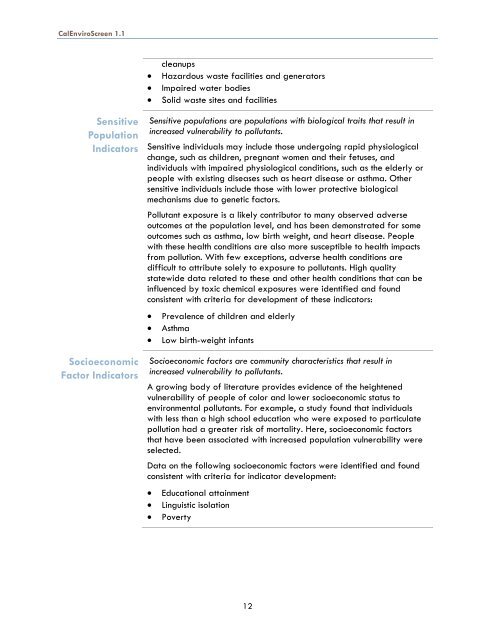CalEnviroscreen Version 1.1 - OEHHA - State of California
CalEnviroscreen Version 1.1 - OEHHA - State of California
CalEnviroscreen Version 1.1 - OEHHA - State of California
You also want an ePaper? Increase the reach of your titles
YUMPU automatically turns print PDFs into web optimized ePapers that Google loves.
CalEnviroScreen <strong>1.1</strong><br />
<br />
<br />
<br />
cleanups<br />
Hazardous waste facilities and generators<br />
Impaired water bodies<br />
Solid waste sites and facilities<br />
Sensitive<br />
Population<br />
Indicators<br />
Socioeconomic<br />
Factor Indicators<br />
Sensitive populations are populations with biological traits that result in<br />
increased vulnerability to pollutants.<br />
Sensitive individuals may include those undergoing rapid physiological<br />
change, such as children, pregnant women and their fetuses, and<br />
individuals with impaired physiological conditions, such as the elderly or<br />
people with existing diseases such as heart disease or asthma. Other<br />
sensitive individuals include those with lower protective biological<br />
mechanisms due to genetic factors.<br />
Pollutant exposure is a likely contributor to many observed adverse<br />
outcomes at the population level, and has been demonstrated for some<br />
outcomes such as asthma, low birth weight, and heart disease. People<br />
with these health conditions are also more susceptible to health impacts<br />
from pollution. With few exceptions, adverse health conditions are<br />
difficult to attribute solely to exposure to pollutants. High quality<br />
statewide data related to these and other health conditions that can be<br />
influenced by toxic chemical exposures were identified and found<br />
consistent with criteria for development <strong>of</strong> these indicators:<br />
<br />
<br />
<br />
Prevalence <strong>of</strong> children and elderly<br />
Asthma<br />
Low birth-weight infants<br />
Socioeconomic factors are community characteristics that result in<br />
increased vulnerability to pollutants.<br />
A growing body <strong>of</strong> literature provides evidence <strong>of</strong> the heightened<br />
vulnerability <strong>of</strong> people <strong>of</strong> color and lower socioeconomic status to<br />
environmental pollutants. For example, a study found that individuals<br />
with less than a high school education who were exposed to particulate<br />
pollution had a greater risk <strong>of</strong> mortality. Here, socioeconomic factors<br />
that have been associated with increased population vulnerability were<br />
selected.<br />
Data on the following socioeconomic factors were identified and found<br />
consistent with criteria for indicator development:<br />
<br />
<br />
<br />
Educational attainment<br />
Linguistic isolation<br />
Poverty<br />
12















